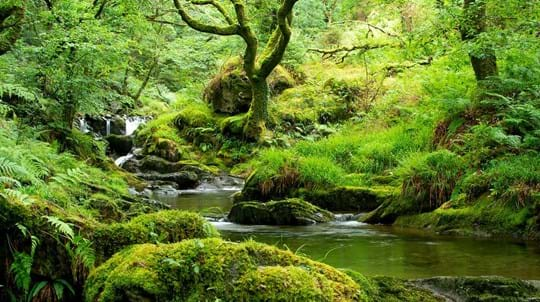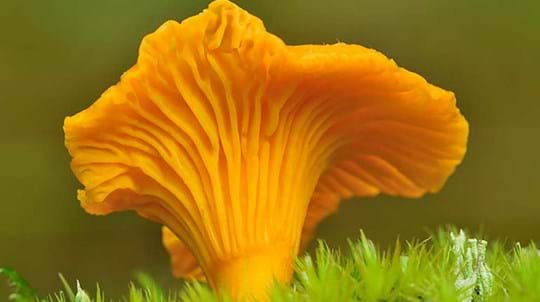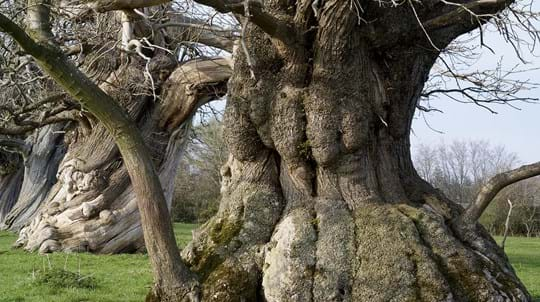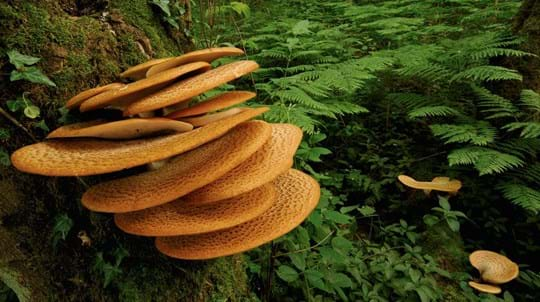
A sign of ancient woodland
Lungwort lichens are ancient-woodland indicators. If you spot them while you're out exploring, it could be a sign you're standing in a rare and special habitat.
Learn more about ancient woodlandOnce common and widespread, they're now pushed to the westernmost extremities of the UK due to air pollution. These lichens of old and ancient woods are among the most impressive and may have life-saving properties.
Common name(s): lungwort, tree lungwort
Scientific name: Lobaria species (including Lobaria pulmonaria, L. virens, L. amplissima, L. scrobiculata)
Family: Lobariaceae
Fruiting season: year-round
Habitat: bark of mature deciduous trees in old woods with low air pollution
Lichens are organisms formed by the symbiosis of a fungus species and one or more other organisms, typically an alga.
Lungworts are known as foliose (leafy) lichens, and are often bright, lush and green when wet. When healthy they can grow to impressive sizes.
Tree lungwort (Lobaria pulmonaria) is formed from a fungus and two algae – a green and a blue-green.
Not to be confused with: similar foliose lichens growing on trees in old woodlands, including dog lichens (Peltigera species) and stinky (Sticta species). Lungworts differ from Sticta lichens because they lack perforations on the lower surface, and are usually browner.
Some lungwort lichens would always have grown in the humid woodlands of the west of the UK (such as Lobaria virens). But others (such as Lobaria pulmonaria) have been pushed west where the air is cleaner.
Lungwort lichens are now only found in old woods and trees in the far west of the UK.
Lobaria pulmonaria once grew on mature oaks, ash, elms and other trees throughout the UK, but its range is now restricted to the Scottish Highlands, with scattered outposts in North Wales, Pembrokeshire, Dartmoor and the New Forest. In some of these sites it is rarely fertile (producing fruit bodies), and so its reproduction is limited.
All lungworts have declined seriously in the past century, but Lobaria scrobiculata has possibly declined the most due to environmental changes; it's now extinct across most of central and southern Europe.

Lungwort lichens are ancient-woodland indicators. If you spot them while you're out exploring, it could be a sign you're standing in a rare and special habitat.
Learn more about ancient woodland
Credit: Alastair Hotchkiss / WTML
Lichens play an important role in the ecology of woodlands. Lichens on trees provide important microhabitats, shelter and food for small invertebrates. These in-turn are prey for larger insects and birds. They can also be hosts for other species of parasitic fungi. Lichens also provide many other ecosystem services such as carbon cycling and water retention for example.
Most lichens do not have old common names, but the fact that Lobaria pulmonaria (tree lungwort) had a name and a use shows how common it must have once been.
The name 'lungwort' dates from long ago when it was thought to have medicinal properties for respiratory ailments.
Tree lungwort resembles the tissue inside lungs and was therefore thought to be a remedy for lung diseases.
In traditional medicine it is, or has been, used to treat a variety of conditions throughout its range. In India it is used in traditional medicine to treat haemorrhages and eczema. In British Columbia, Canada, the Hesquiaht use it as a remedy for coughing up blood. In the high Molise region in Italy it is used as an antiseptic for wounds.
Lungworts have also been used to produce an orange dye for wool and leather, and to make perfumes and beer.

Blog
Kylie Harrison Mellor • 24 Apr 2019

Trees woods and wildlife
Also known as Atlantic or Celtic rainforest, this special habitat is incredibly rare. Its lush conditions are perfect for scarce plants, lichens and fungi, as well as a number of unusual animals.

Trees woods and wildlife
A dazzling array of shapes, sizes and colours. Find out about fungi and lichens, from ancient taboos to magic and medicine.

Trees woods and wildlife
How long do trees live? How old before they're ancient? Get the low-down on ancient trees and where to find them in the UK.

Blog
Amy Lewis • 21 Oct 2021